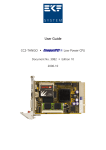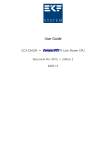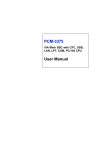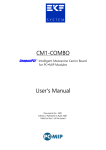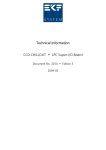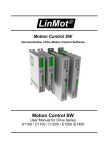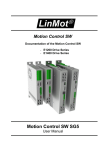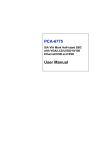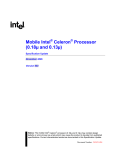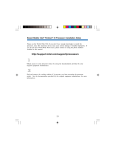Download User Guide CC7-JAZZ • CompactPCI ® FC-PGA2 CPU
Transcript
User Guide CC7-JAZZ • CompactPCI ® FC-PGA2 CPU Document No. 2706 • Edition 4 03-2004 User Guide CC7-JAZZ • FC-PGA2 CompactPCI CPU Contents About this Manual . . . . . . . . . . . . . . . . . . . . . . . . . . . . . . . . . . . . . . . . . . . . . . . . . . . . . . . Edition History . . . . . . . . . . . . . . . . . . . . . . . . . . . . . . . . . . . . . . . . . . . . . . . . . . . . . Related Documents . . . . . . . . . . . . . . . . . . . . . . . . . . . . . . . . . . . . . . . . . . . . . . . . . Nomenclature . . . . . . . . . . . . . . . . . . . . . . . . . . . . . . . . . . . . . . . . . . . . . . . . . . . . . Trade Marks . . . . . . . . . . . . . . . . . . . . . . . . . . . . . . . . . . . . . . . . . . . . . . . . . . . . . . Legal Disclaimer - Liability Exclusion . . . . . . . . . . . . . . . . . . . . . . . . . . . . . . . . . . . . . 4 4 5 5 5 5 CC7-JAZZ Features . . . . . . . . . . . . . . . . . . . . . . . . . . . . . . . . . . . . . . . . . . . . . . . . . . . . . . . 6 Feature Summary . . . . . . . . . . . . . . . . . . . . . . . . . . . . . . . . . . . . . . . . . . . . . . . . . . 6 Short Description CC7-JAZZ . . . . . . . . . . . . . . . . . . . . . . . . . . . . . . . . . . . . . . . . . . . 7 Block Diagram CC7-JAZZ . . . . . . . . . . . . . . . . . . . . . . . . . . . . . . . . . . . . . . . . . . . . . 8 Expansion Module CC6-ACID . . . . . . . . . . . . . . . . . . . . . . . . . . . . . . . . . . . . . . . . . . 9 Computer Cartridge CCF-CONCERT . . . . . . . . . . . . . . . . . . . . . . . . . . . . . . . . . . . . 11 Top View Component Assembly CC7-JAZZ . . . . . . . . . . . . . . . . . . . . . . . . . . . . . . . 12 Strapping Headers . . . . . . . . . . . . . . . . . . . . . . . . . . . . . . . . . . . . . . . . . . . . . . . . . 13 Connectors & Sockets . . . . . . . . . . . . . . . . . . . . . . . . . . . . . . . . . . . . . . . . . . . . . . 13 Front Panel Elements . . . . . . . . . . . . . . . . . . . . . . . . . . . . . . . . . . . . . . . . . . . . . . . 13 Microprocessor . . . . . . . . . . . . . . . . . . . . . . . . . . . . . . . . . . . . . . . . . . . . . . . . . . . 14 Thermal Considerations . . . . . . . . . . . . . . . . . . . . . . . . . . . . . . . . . . . . . . . . . . . . . 17 Main Memory . . . . . . . . . . . . . . . . . . . . . . . . . . . . . . . . . . . . . . . . . . . . . . . . . . . . 19 LAN Subsystem . . . . . . . . . . . . . . . . . . . . . . . . . . . . . . . . . . . . . . . . . . . . . . . . . . . 19 Enhanced IDE Interface . . . . . . . . . . . . . . . . . . . . . . . . . . . . . . . . . . . . . . . . . . . . . 19 Graphics Subsystem . . . . . . . . . . . . . . . . . . . . . . . . . . . . . . . . . . . . . . . . . . . . . . . 20 Real-Time Clock . . . . . . . . . . . . . . . . . . . . . . . . . . . . . . . . . . . . . . . . . . . . . . . . . . . 22 Universal Serial Bus (USB) . . . . . . . . . . . . . . . . . . . . . . . . . . . . . . . . . . . . . . . . . . . 22 LPC Super- I/O Interface . . . . . . . . . . . . . . . . . . . . . . . . . . . . . . . . . . . . . . . . . . . . . 22 Watchdog/Reset . . . . . . . . . . . . . . . . . . . . . . . . . . . . . . . . . . . . . . . . . . . . . . . . . . 23 Firmware Hub (Flash BIOS) . . . . . . . . . . . . . . . . . . . . . . . . . . . . . . . . . . . . . . . . . . 24 IDE (Hard Disk Activity) LED . . . . . . . . . . . . . . . . . . . . . . . . . . . . . . . . . . . . . . . . . . 24 GP (General Purpose) LED . . . . . . . . . . . . . . . . . . . . . . . . . . . . . . . . . . . . . . . . . . . 24 Hot Swap Detection . . . . . . . . . . . . . . . . . . . . . . . . . . . . . . . . . . . . . . . . . . . . . . . 25 Power Supply Status (DEG#, FAL#) . . . . . . . . . . . . . . . . . . . . . . . . . . . . . . . . . . . . 25 PXI Trigger Signals . . . . . . . . . . . . . . . . . . . . . . . . . . . . . . . . . . . . . . . . . . . . . . . . . 25 Installing and Replacing Components . . . . . . . . . . . . . . . . . . . . . . . . . . . . . . . . . . . . . . . . Before You Begin . . . . . . . . . . . . . . . . . . . . . . . . . . . . . . . . . . . . . . . . . . . . . . . . . . Warnings . . . . . . . . . . . . . . . . . . . . . . . . . . . . . . . . . . . . . . . . . . . . . . . . . . Caution . . . . . . . . . . . . . . . . . . . . . . . . . . . . . . . . . . . . . . . . . . . . . . . . . . . Installing the Board . . . . . . . . . . . . . . . . . . . . . . . . . . . . . . . . . . . . . . . . . . . . . . . . Removing the Board . . . . . . . . . . . . . . . . . . . . . . . . . . . . . . . . . . . . . . . . . . . . . . . EMC Recommendations . . . . . . . . . . . . . . . . . . . . . . . . . . . . . . . . . . . . . . . . . . . . . Installing or Replacing the Processor . . . . . . . . . . . . . . . . . . . . . . . . . . . . . . . . . . . Installing or Replacing the Memory Module . . . . . . . . . . . . . . . . . . . . . . . . . . . . . . Replacement of the Battery . . . . . . . . . . . . . . . . . . . . . . . . . . . . . . . . . . . . . . . . . . 26 26 26 26 27 28 29 30 30 31 Technical Reference . . . . . . . . . . . . . . . . . . . . . . . . . . . . . . . . . . . . . . . . . . . . . . . . . . . . . 32 -2EKF Elektronik GmbH • Philipp-Reis-Str. 4 • 59065 HAMM • Germany Tel. +49 (0)2381/6890-0 • Fax. +49 (0)2381/6890-90 • E-Mail [email protected] • Internet http://www.ekf.de User Guide CC7-JAZZ • FC-PGA2 CompactPCI CPU Local PCI Devices . . . . . . . . . . . . . . . . . . . . . . . . . . . . . . . . . . . . . . . . . . . . . . . . . . Local SMB Devices . . . . . . . . . . . . . . . . . . . . . . . . . . . . . . . . . . . . . . . . . . . . . . . . . Connectors . . . . . . . . . . . . . . . . . . . . . . . . . . . . . . . . . . . . . . . . . . . . . . . . . . . . . . Caution . . . . . . . . . . . . . . . . . . . . . . . . . . . . . . . . . . . . . . . . . . . . . . . . . . . Front Panel Connectors . . . . . . . . . . . . . . . . . . . . . . . . . . . . . . . . . . . . . . . . Video Monitor Connector DVI-I . . . . . . . . . . . . . . . . . . . . . . . . . . . . USB Connector . . . . . . . . . . . . . . . . . . . . . . . . . . . . . . . . . . . . . . . . Ethernet Connector . . . . . . . . . . . . . . . . . . . . . . . . . . . . . . . . . . . . . Internal Connectors . . . . . . . . . . . . . . . . . . . . . . . . . . . . . . . . . . . . . . . . . . LPC Low Pin Count Header . . . . . . . . . . . . . . . . . . . . . . . . . . . . . . . . ATA/IDE Header . . . . . . . . . . . . . . . . . . . . . . . . . . . . . . . . . . . . . . . . Fan Heatsink Header . . . . . . . . . . . . . . . . . . . . . . . . . . . . . . . . . . . . Speaker Header . . . . . . . . . . . . . . . . . . . . . . . . . . . . . . . . . . . . . . . . PLD Programming Header . . . . . . . . . . . . . . . . . . . . . . . . . . . . . . . . Processor Debug Header . . . . . . . . . . . . . . . . . . . . . . . . . . . . . . . . . CompactPCI J1 . . . . . . . . . . . . . . . . . . . . . . . . . . . . . . . . . . . . . . . . . CompactPCI J2 . . . . . . . . . . . . . . . . . . . . . . . . . . . . . . . . . . . . . . . . . Recommended Power Supply Specifications . . . . . . . . . . . . . . . . . . . . . . . . . . . . . . Typical Power Consumption . . . . . . . . . . . . . . . . . . . . . . . . . . . . . . . . . . . . . . . . . . Literature . . . . . . . . . . . . . . . . . . . . . . . . . . . . . . . . . . . . . . . . . . . . . . . . . . . . . . . 32 32 33 33 33 34 34 35 36 36 37 38 38 38 39 40 41 42 42 42 -3EKF Elektronik GmbH • Philipp-Reis-Str. 4 • 59065 HAMM • Germany Tel. +49 (0)2381/6890-0 • Fax. +49 (0)2381/6890-90 • E-Mail [email protected] • Internet http://www.ekf.de User Guide CC7-JAZZ • FC-PGA2 CompactPCI CPU About this Manual This manual describes the technical aspects of the CC7-JAZZ, required for installation and system integration. It is intended for the experienced user only. Edition History Document Text # 2706 cc7_uge.wpd Ed. Contents/Changes Author Date 1 User Manual CC7-JAZZ English jj 20 August 2002 2 Added power consumption details jj 29 January 2003 3 Chapter 'Thermal Considerations', modified information regarding throttle mode jj 14 March 2003 4 Chapter 'Thermal Considerations', modified board replacement recommendation for high ambient temperature jj 26 March 2004 -4EKF Elektronik GmbH • Philipp-Reis-Str. 4 • 59065 HAMM • Germany Tel. +49 (0)2381/6890-0 • Fax. +49 (0)2381/6890-90 • E-Mail [email protected] • Internet http://www.ekf.de User Guide CC7-JAZZ • FC-PGA2 CompactPCI CPU Related Documents For a description of the CC7-JAZZ BIOS see document 'CC7-JAZZ BIOS Quick Reference', available by download at http://www.ekf.de/c/ccpu/cc7/cc7.html. Nomenclature Signal names used herein with an attached '#' designate active low lines. Trade Marks Some terms used herein are property of their respective owners, e.g. Intel, Pentium, Celeron, Tualatin, Coppermine, Socket 370: ® Intel CompactPCI : ® PICMG Windows 98, Windows NT, Windows 2000: ® Microsoft EKF does not claim this list to be complete. Legal Disclaimer - Liability Exclusion This manual has been edited as carefully as possible. We apologize for any potential mistake. Information provided herein is designated exclusively to the proficient user (system integrator, engineer). EKF can accept no responsibility for any damage caused by the use of this manual. -5EKF Elektronik GmbH • Philipp-Reis-Str. 4 • 59065 HAMM • Germany Tel. +49 (0)2381/6890-0 • Fax. +49 (0)2381/6890-90 • E-Mail [email protected] • Internet http://www.ekf.de User Guide CC7-JAZZ • FC-PGA2 CompactPCI CPU CC7-JAZZ Features Feature Summary Feature Summary CC7-JAZZ Form Factor Single size CompactPCI style Eurocard (160x100mm2), front panel width 4HP (20.3mm) Processor Designed for Intel® CeleronTM, Pentium® III processors (Tualatin 0.13u) Chip Set i815G chip set consisting of: • 82815 Graphics/Memory Controller Hub (GMCH) • 82801 I/O Controller Hub (ICH) • 82802 Firmware Hub (FWH) Memory • 144-pin SO-DIMM socket, module height 1.15" (30mm) max. • Support for up to 512MB, PC133, non ECC, unbuffered SDRAM • Support for serial presence detect (SPD) and non-SPD SO-DIMMs Video I/O Analog monitor and digital flat-panel display support by DVI-I connector (front panel), up to 1280x1024 pixel 16M colors 85Hz refresh rate, incorporates PanelLink Digital technology (Silicon Image) USB I/O Single type A connector (front panel), USB1.1, data transfer rate of up to 12Mbit/s Ethernet I/O 10/100/1000Mbps Gigabit Ethernet controller, 82540 chip, RJ-45 connector available from the front panel Legacy I/O LPC Super-I/O interface connector, CC6-ACID companion board with Super-I/O controller available IDE/ATA • Ultra ATA/66 40-pin connector (primary IDE) • CompactFlash socket for CFA ATA cards (secondary IDE) CompactPCI 32-bit, 33.3MHz, PCI bridge chip Texas Instruments PCI2050, 133MBps CPCI master BIOS General Software Embedded 2000 BIOS, 2..8Mbit Flash Memory Power Requirements +5V ± 5% 5.8A max. +3.3V ± 5% 2.2A max. (CC7-1) 2.4A max. (CC7-2) +12V ± 5% 0.45A max. -6EKF Elektronik GmbH • Philipp-Reis-Str. 4 • 59065 HAMM • Germany Tel. +49 (0)2381/6890-0 • Fax. +49 (0)2381/6890-90 • E-Mail [email protected] • Internet http://www.ekf.de User Guide CC7-JAZZ • FC-PGA2 CompactPCI CPU Short Description CC7-JAZZ Alternatively equipped with the Intel 0.13u Tualatin-Celeron® or -Pentium III® 1.26GHz processor, the CC7-JAZZ is a powerful 3U (single size Eurocard) CPU board, well suitable for any CompactPCI® systems. As a mass storage interface, the CC7-JAZZ provides an Ultra ATA/66 connector, suitable for hard disk drives and CD-ROM. A receptacle for Compact-FLASH cards allows utilization of silicon disks. The board is provided with the chip set 815G, which contains an embedded graphics controller. The DVI-I interface allows for attachment of both, advanced (digital) and legacy (analog) flat panel displays and CRT monitors. The main memory is a SO-DIMM 144 form factor module up to 512MB/PC133. The jumperless board can be used with a FSB and memory clock of up to 133MHz. The on-board USB-port is an universal interface to a variety of peripheral devices. For high speed networking, the CC7-JAZZ is provided with a 1000Mbps Gigabit Ethernet twisted pair jack. All connectors mentioned above are comfortably available from the cards front panel. Equipped with a PCI-bridge chip, the CC7JAZZ offers a full CPCI interface for reliable system expansion. Especially designed for embedded systems applications, the General Software BIOS source code is maintained by EKF. So custom specific enhancements can be realized at anytime. -7EKF Elektronik GmbH • Philipp-Reis-Str. 4 • 59065 HAMM • Germany Tel. +49 (0)2381/6890-0 • Fax. +49 (0)2381/6890-90 • E-Mail [email protected] • Internet http://www.ekf.de User Guide CC7-JAZZ • FC-PGA2 CompactPCI CPU Block Diagram CC7-JAZZ CC7-JAZZ Block Diagram -8EKF Elektronik GmbH • Philipp-Reis-Str. 4 • 59065 HAMM • Germany Tel. +49 (0)2381/6890-0 • Fax. +49 (0)2381/6890-90 • E-Mail [email protected] • Internet http://www.ekf.de User Guide CC7-JAZZ • FC-PGA2 CompactPCI CPU Expansion Module CC6-ACID Available as a companion board to the CC7JAZZ, the CC6-ACID is provided with several legacy I/O ports. This module can be mounted either to the bottom side or on top of the CC7-JAZZ and communicates across the LPC (Low Pin Count) interface. The CC6ACID will be required only if the classical interfaces, e.g. serial and parallel port remain in use in a given application. As an option, the CC6-ACID can be delivered with an on-board 2.5" hard disk drive, resulting in a very compact system. The connectors COM1/2, LPT, mouse and keyboard are situated at the front panel (4HP and 8HP versions available), while an external floppy disk drive can be attached via the onboard pin header. CC6-ACID Block Diagram -9EKF Elektronik GmbH • Philipp-Reis-Str. 4 • 59065 HAMM • Germany Tel. +49 (0)2381/6890-0 • Fax. +49 (0)2381/6890-90 • E-Mail [email protected] • Internet http://www.ekf.de User Guide CC7-JAZZ • FC-PGA2 CompactPCI CPU CC6-ACID (4HP) CC6-ACID (8HP) - 10 EKF Elektronik GmbH • Philipp-Reis-Str. 4 • 59065 HAMM • Germany Tel. +49 (0)2381/6890-0 • Fax. +49 (0)2381/6890-90 • E-Mail [email protected] • Internet http://www.ekf.de User Guide CC7-JAZZ • FC-PGA2 CompactPCI CPU Computer Cartridge CCF-CONCERT In addition to the CC6-ACID with its onboard hard disk drive, the CC7-JAZZ can be combined with a slim-line floppy disk drive. This CompactPCI computer is named CCFCONCERT. Housed in a 3U cassette, the entire computer requires only 12HP mounting space, while surpassing the whole functionality of a powerful PC. CCF-CONCERT - 11 EKF Elektronik GmbH • Philipp-Reis-Str. 4 • 59065 HAMM • Germany Tel. +49 (0)2381/6890-0 • Fax. +49 (0)2381/6890-90 • E-Mail [email protected] • Internet http://www.ekf.de User Guide CC7-JAZZ • FC-PGA2 CompactPCI CPU Top View Component Assembly CC7-JAZZ - 12 EKF Elektronik GmbH • Philipp-Reis-Str. 4 • 59065 HAMM • Germany Tel. +49 (0)2381/6890-0 • Fax. +49 (0)2381/6890-90 • E-Mail [email protected] • Internet http://www.ekf.de User Guide CC7-JAZZ • FC-PGA2 CompactPCI CPU Strapping Headers ISPCON In System Programmable GAL (PLD programming), not stuffed JFAN Cooling fan connector, 12V or 5V fixed operation JSPKR Speaker connector Connectors & Sockets CFA1 CompactFlash ATA socket (secondary IDE interface) J1/J2 CompactPCI Bus & PXI PLPCT PLPCB Low Pin Count expansion interface connector (Super-I/O), available either from top (T) or bottom (B) of the board PIDE Ultra ATA/66 connector (primary IDE interface) PITP CPU Debug Port, not normally stuffed SODIMM1 144-pin memory module SDRAM PC133 Front Panel Elements Ethernet 1000Base-TX/100Base-TX/10Base-T, RJ-45 receptacle with integrated indicator LEDs Graphics DVI-I receptacle, suitable for DVI digital flat panel displays and/or analog monitors USB Universal Serial Bus 1.1 self powered root hub, type A receptacle Reset Push-button switch with integrated indicator LED (power good) IDE LED indicating IDE activity GPIO Special purpose LED - 13 EKF Elektronik GmbH • Philipp-Reis-Str. 4 • 59065 HAMM • Germany Tel. +49 (0)2381/6890-0 • Fax. +49 (0)2381/6890-90 • E-Mail [email protected] • Internet http://www.ekf.de User Guide CC7-JAZZ • FC-PGA2 CompactPCI CPU Microprocessor The CC7-JAZZ supports 370-pin FC-PGA2 socketed Celeron® and Pentium®-III processors listed below. The FC-PGA2 processors are also known as Tualatin 0.13u generation (CPU ID 06bxh). The CC7 is not suitable for 0.18u Coppermine FC-PGA processors. The table below lists typical processors available for the CC7-JAZZ (there might be other resources not mentioned here). Please note: Use of any processor not supported can cause permanent damage to the processor and the CC7-JAZZ! Neither have all of the CPU types mentioned in the tables below been tested by EKF for use with the CC7-JAZZ, nor does EKF claim that the entire range of processors is available for purchase. Instead, please refer to the EKF price list http://www.ekf.de/liste/liste_20.html for availability of the CC7-JAZZ with particular processors (your individual request to [email protected] is very welcome). Please do not attempt to change or remove the installed processor by yourself. The CC7-JAZZ is equipped with a non-ZIF processor socket, which requires special handling to remove the CPU. In addition, the passive heatsink is fixed by several screws, which need to be precisely adjusted in order achieve the optimum heat conduction. Furthermore, the heatsink is fixed with conductive pads and/or adhesion to the Tualatin processors integrated heat spreader, which cannot be removed and renewed without suitable material and knowledge. If it is required to identify a particular processor, use suitable software instead, like Intels freely available Processor Frequency ID Utility. Do not confuse the processor host bus frequency (FSB front side bus or PSB processor side bus) with the memory speed or the PCI clock, which are independent from each other. The processor signals its appropriate basic speed by two pins to the chipset, which is thereby adjusted automatically (no user interaction required). The internal CPU speed is achieved by multiplying the host bus frequency by a fixed value. The CC7-JAZZ is powered across the CompactPCI connectors J1/J2 (3.3V, 5V, 12V). The processor core voltage is generated by a switched voltage regulator, sourced from the 5V plane. Any FC-PGA2 370 processor signals its required core voltage by 5 dedicated pins, hence there is no need (no choice) for user adjustment. Manipulation of these parameters (the euphemistic term 'tuning' is widely in use for that) may lead to unpredictable results. - 14 EKF Elektronik GmbH • Philipp-Reis-Str. 4 • 59065 HAMM • Germany Tel. +49 (0)2381/6890-0 • Fax. +49 (0)2381/6890-90 • E-Mail [email protected] • Internet http://www.ekf.de User Guide CC7-JAZZ • FC-PGA2 CompactPCI CPU Celeron® 0.13: Processors Currently Supported (as of 08/2002) Processor Speed Host Bus L2 Cache CPU ID Package Stepping Celeron 1.00GHz 100MHz 256KB 06B1h FC-PGA2 A1 Celeron 1.00GHz 100MHz 256KB 06B4h FC-PGA2 B1 Celeron 1.10GHz 100MHz 256KB 06B1h FC-PGA2 A1 Celeron 1.10GHz 100MHz 256KB 06B4h FC-PGA2 B1 Celeron 1) 1.20GHz 100MHz 256KB 06B1h FC-PGA2 A1 Celeron 1) 1.20GHz 100MHz 256KB 06B4h FC-PGA2 B1 Celeron 1.30GHz 100MHz 256KB 06B1h FC-PGA2 A1 Celeron 1.30GHz 100MHz 256KB 06B4h FC-PGA2 B1 Celeron 1.40GHz 100MHz 256KB 06B1h FC-PGA2 A1 Celeron 1.40GHz 100MHz 256KB 06B4h FC-PGA2 B1 1) following the Intel Embedded Roadmap, this processor is recommended for long time availability - 15 EKF Elektronik GmbH • Philipp-Reis-Str. 4 • 59065 HAMM • Germany Tel. +49 (0)2381/6890-0 • Fax. +49 (0)2381/6890-90 • E-Mail [email protected] • Internet http://www.ekf.de User Guide CC7-JAZZ • FC-PGA2 CompactPCI CPU Pentium®-III 0.13: Processors Currently Supported (as of 08/2002) Processor Speed Host Bus L2 Cache CPU ID Package Stepping Pentium-III 1.00GHz 133MHz 256KB 06b1h FC-PGA2 A1 Pentium-III 1.13GHz 133MHz 256KB 06b1h FC-PGA2 A1 Pentium-III 1.13GHz 133MHz 256KB 06b4h FC-PGA2 B1 Pentium-III 1.20GHz 133MHz 256KB 06b1h FC-PGA2 A1 Pentium-III 1.20GHz 133MHz 256KB 06b4h FC-PGA2 B1 Pentium-III 1.33GHz 133MHz 256KB 06b1h FC-PGA2 A1 Pentium-III 1.33GHz 133MHz 256KB 06b4h FC-PGA2 B1 Pentium-III 1.40GHz 133MHz 256KB 06b1h FC-PGA2 A1 Pentium-III 1.40GHz 133MHz 256KB 06b4h FC-PGA2 B1 Pentium-III 1.13GHz 133MHz 512KB 06b1h FC-PGA2 A1 Pentium-III 1.13GHz 133MHz 512KB 06b4h FC-PGA2 B1 Pentium-III 1) 1.26GHz 133MHz 512KB 06b1h FC-PGA2 A1 Pentium-III 1) 1.26GHz 133MHz 512KB 06b4h FC-PGA2 B1 Pentium-III 1.40GHz 133MHz 512KB 06b1h FC-PGA2 A1 Pentium-III 1.40GHz 133MHz 512KB 06b4h FC-PGA2 B1 1) following the Intel Embedded Roadmap, this processor is recommended for long time availability - 16 EKF Elektronik GmbH • Philipp-Reis-Str. 4 • 59065 HAMM • Germany Tel. +49 (0)2381/6890-0 • Fax. +49 (0)2381/6890-90 • E-Mail [email protected] • Internet http://www.ekf.de User Guide CC7-JAZZ • FC-PGA2 CompactPCI CPU Thermal Considerations In order to avoid malfunctioning of the CC7-JAZZ, take care of appropriate cooling of the processor and system, e.g. by a cooling fan suitable to the maximum power consumption of the CPU chip actually in use. Please note, that the processors temperature is steadily measured by a special controller (MAX1617), attached to the onboard SMBus® (System Management Bus). The processor core (die) temperature is signalled by the forward voltage of a CPU integrated diode. A second diode internal to the MAX1617 allows for acquisition of the boards surface temperature. The programmable over-temperature alarm allows to trigger the SMBus alert line in order to avoid overheating. A suitable software to display both, the die temperature, as well as the board temperature, is MBM (Motherboard Monitor), which can be downloaded from the web. After installation, both temperatures can be observed permanently from the Windows taskbar. By default, the CC7-JAZZ is equipped with a passive heatsink, covering not only the processor chip itself but also major areas on the board, for an optimum thermal conduction. In addition, a forced vertical air flow through the system enclosure (e.g. bottom mount fan unit) is strongly recommended (>15m3/h around the CPU slot). Be sure to thoroughly discuss your actual cooling needs with EKF. Generally, the faster the CPU speed the higher is its power consumption. The maximum power consumption and operating temperature of a particular processor can be derived from the tables below. Fortunately, the power consumption is by far lower when executing typical Windows or Linux tasks. The heat dissipation increases especially when rendering software is executed, e.g. the Acrobat Distiller. EKF tests the CC7-JAZZ by running 'kpower.exe', a proprietary Intel tool for generating the maximum stress to the processor. CC7-JAZZ See-Through Heatsink - 17 EKF Elektronik GmbH • Philipp-Reis-Str. 4 • 59065 HAMM • Germany Tel. +49 (0)2381/6890-0 • Fax. +49 (0)2381/6890-90 • E-Mail [email protected] • Internet http://www.ekf.de User Guide CC7-JAZZ • FC-PGA2 CompactPCI CPU Celeron® 0.13: Processors Maximum Power Consumption and Die Temperature Processor Speed Host Bus L2 Cache CPU ID maximum Power max. Die Temperature Celeron 1.00GHz 100MHz 256KB 06B1h 27.8W 69/C Celeron 1.00GHz 100MHz 256KB 06B4h 29.5W 69/C Celeron 1.10GHz 100MHz 256KB 06B1h 28.9W 69/C Celeron 1.10GHz 100MHz 256KB 06B4h 29.5W 69/C Celeron 1.20GHz 100MHz 256KB 06B1h 29.9W 69/C Celeron 1.20GHz 100MHz 256KB 06B4h 32.0W 69/C Celeron 1.30GHz 100MHz 256KB 06B1h 33.4W 71/C Celeron 1.30GHz 100MHz 256KB 06B4h 32.0W 69/C Celeron 1.40GHz 100MHz 256KB 06B1h 34.8W 72/C Celeron 1.40GHz 100MHz 256KB 06B4h tbd 69/C Pentium®-III 0.13: Processors Maximum Power Consumption and Die Temperature Processor Speed Host Bus L2 Cache CPU ID maximum Power max. Die Temperature Pentium-III 1.13GHz 133MHz 512KB 06B1h 27.9W 69/ Pentium-III 1.13GHz 133MHz 512KB 06B4h 28.7W 69/ Pentium-III 1.26GHz 133MHz 512KB 06B1h 29.5W 69/ Pentium-III 1.26GHz 133MHz 512KB 06B4h 30.4W 69/ Pentium-III 1.40GHz 133MHz 512KB 06B1h tbd 69/ Pentium-III 1.40GHz 133MHz 512KB 06B4h 32.2W 69/ A special method to reduce power consumption and therefore increasing the maximum ambient temperature, is to force the processor into the 'Throttle Mode'. This is achieved by actuating the 'Stop Clock' input of the CPU, and can be activated through the BIOS settings. A Throttle Mode of 50% e.g. means a duty cycle of 50% on the stop clock input. However, while saving a certain amount in power consumption, the data throughput of the processor is also reduced. Unfortunately, the 0.13: generation of P3 processors requires a considerably high bias current, which seems nearly independent from the chosen throttle mode percentage. Hence, if the application demands for an ambient temperature of up to 70/C or even more, the CC2-TANGO is highly recommended. It is provided with a Ultra Low Voltage Celeron or Low Voltage Pentium III processor, which is designed for considerable power savings and can withstand 100/C die temperature. - 18 EKF Elektronik GmbH • Philipp-Reis-Str. 4 • 59065 HAMM • Germany Tel. +49 (0)2381/6890-0 • Fax. +49 (0)2381/6890-90 • E-Mail [email protected] • Internet http://www.ekf.de User Guide CC7-JAZZ • FC-PGA2 CompactPCI CPU Main Memory The CC7-JAZZ is equipped with a socket for installing a single 144-pin SO-DIMM module (module height limited to <=1.100 inch). Minimum memory size is 32MB; maximum memory size is 512MB. Due to the video requirements of the i815 chipset, minimum memory for the Windows NT 4.0 and Windows 2000 operating system is 64MB (some of the system memory is dedicated to the graphics controller). The supported on-board memory is entirely chacheable. The memory module is a unbuffered SD-RAM, PC133 style. The contents of the SPD eeprom are displayed on system start by the BIOS. The memory clock is 133MHz maximum, due to limitations of the 815GMCH. LAN Subsystem The Intel 82540 Gigabit Ethernet PCI LAN subsystem provides also legacy 10Base-T and 100Base-TX connectivity. Features include: C C C C PCI bus mastering 32-bit, 33MHz 1000Base-Tx (Gigabit Ethernet), 100Base-TX (Fast Ethernet, half- or full-duplex) and 10Base-T (Classic Ethernet) capability using a single RJ-45 connector IEEE 802.3: Auto-Negotiation for the fastest available connection Jumperless configuration (complete software-configurable) Three display LEDs integrated into the RJ-45 connector signal the LAN connection speed and the LAN link and activity status. The Intel 82540 Gigabit Ethernet PCI LAN software and drivers are available from Intel's World Wide Web site. Enhanced IDE Interface The EIDE interface handles the exchange of information between the processor and peripheral devices like hard disks, ATA CompactFlash cards and CD-ROM drives. The interface supports: C C C Up to three ATA devices (2 IDE, 1 CompactFlash) PIO Mode 3/4, Ultra ATA/33, Ultra ATA/66 Support for LS-120 drives The primary IDE interface is routed to a standard 40-position header (2.54mm pitch), allowing master and slave device attached to one common flat ribbon cable (use special 80-pin cabling assembly for Ultra ATA/66 operation). The presence of an 80-pin cable at the primary IDE interface could be checked out by reading the state of the GPI0 of the Firmware Hub (FWH). The ATA standard defines the signal PDIAG-/CBLID- for identifying the cable. This line is routed to GPI0 of the FWH. A logical 1 signals a 40-pin, a logical 0 a 80-pin cable. See the ATA/ATAPI-6 specification (section 6.7 “Host determination of cable type by detecting CBLID-“) for details. - 19 EKF Elektronik GmbH • Philipp-Reis-Str. 4 • 59065 HAMM • Germany Tel. +49 (0)2381/6890-0 • Fax. +49 (0)2381/6890-90 • E-Mail [email protected] • Internet http://www.ekf.de User Guide CC7-JAZZ • FC-PGA2 CompactPCI CPU The secondary IDE interface is routed to the CompactFlash Card Adapter socket. Use this connector to attach a CompactFlash ATA style silicon disk, whenever a hard disk is not suitable for your system, or as an additional mass storage device. A display LED, situated in the front panel near the reset push-button, signals disk activity status of the primary IDE devices and also the CompactFlash slot. This LED is also software programmable. See the section “Programmable LED” how to do this. Graphics Subsystem The graphics subsystem is part of the Intel 82815 Graphic/Memory Controller Hub (GMCH), supporting the following features: C C C C C C C C 3-D Hyper Pipelined architecture Full 2-D hardware acceleration Motion video acceleration 3-D graphics visual and texturing enhancements Integrated 24-bit 230MHz RAMDAC DDC2B compliant Hardware motion compensation for software MPEG2 decode Integrated graphics memory controller The CC7-JAZZ is provided with the DVI-I graphics connector. This is both a digital and analog interface. Recent digital input flat-panel displays are already available with this connector style. Adapter cables can be used for converting to the 15-pin HD-SUB connector. A special display transmitter chip is used for serializing/deserializing the differential DVI signals. The SiI 164 (Silicon Image) transmitter uses PanelLink® Digital technology to support displays ranging from VGA to SXGA resolutions (25 - 112Mpps) in a single link interface. The SiI 164 transmitter has a highly flexible interface with 12-bit (½ pixel/clock) or 24-bit (1 pixel/clock) input for true color (16.7 million) support. It can be foreseen, that DVI will overcome the legacy analog and proprietary digital interfaces in the near future. - 20 EKF Elektronik GmbH • Philipp-Reis-Str. 4 • 59065 HAMM • Germany Tel. +49 (0)2381/6890-0 • Fax. +49 (0)2381/6890-90 • E-Mail [email protected] • Internet http://www.ekf.de User Guide CC7-JAZZ • FC-PGA2 CompactPCI CPU i815 GMCH Refresh Rates Resolution Color 60Hz 640x200 16 ! 640x350 16 ! 640x400 256 ! 64K ! 16M 640x480 800x600 1024x768 70Hz 72Hz 75Hz 85Hz ! ! ! ! ! ! ! ! ! ! ! ! ! ! ! 16 ! 256 ! 32K ! 64K ! ! ! ! ! 16M ! ! ! ! ! 256 ! ! ! ! ! 32K ! ! ! 64K ! ! ! ! ! 16M ! ! ! ! ! 256 ! ! ! ! 32K ! ! ! 64K ! ! ! ! ! 16M ! ! ! ! ! ! ! ! ! ! ! 1056x800 16 1280x1024 256 ! 32K ! 64K ! ! ! ! ! 16M ! ! ! ! ! ! ! - 21 EKF Elektronik GmbH • Philipp-Reis-Str. 4 • 59065 HAMM • Germany Tel. +49 (0)2381/6890-0 • Fax. +49 (0)2381/6890-90 • E-Mail [email protected] • Internet http://www.ekf.de User Guide CC7-JAZZ • FC-PGA2 CompactPCI CPU Real-Time Clock The CC7-JAZZ has a time-of-day clock and 100-year calendar. A battery on the board keeps the clock current when the computer is turned off. The CC7 uses a Vanadium-Pentoxide-Lithium rechargeable battery, giving an autonomy of more than 80 days when fully loaded after 24 hours. The cell is free of memory effects and withstands deep discharging. Under normal conditions, replacement should be superfluous during lifetime of the board. Universal Serial Bus (USB) The CC7-JAZZ is provided with a single USB 1.1 port, routed to a front panel connector. You can connect a USB peripheral device directly to the CC7 without an external hub. To attach more devices, connect an external hub to the CC7 built-in port (often monitors or keyboards provide USB hub functionality). The USB connector can source up to 0.5A/5V, and is protected by a Polyswitch resettable fuse against shortening. LPC Super- I/O Interface In a modern system, legacy ports as PS/2 Keyboard/Mouse, COM1/2 and LPT have been replaced by USB and Ethernet connectivity. The 1.4MB floppy disk drive has been swapped against LS120 or CD-RW drives, attached to the IDE connector. Hence, the CC7-JAZZ is virtually provided with all necessary I/O ports. Though, for applications with inevitable demand for legacy I/O, EKF offers the CC6-ACID, an expansion module to the CC7-JAZZ, featuring all classic Super-I/O functionality. The CC6-ACID is a 3U Eurocard, with an either 8HP (double) or 4HP (single) width front panel. Access to the connectors COM1/2, LPT, mouse, keyboard is given directly from the front panel. Onboard connectors are provided for FDD, MIDI/Gameport, and cooling fans. Optionally, the CC6 is available with an onboard 2.5" hard disk drive. The CC6-ACID connects to the CC7-JAZZ across the connector LPCT or LPCB (LPC = Low Pin Count interface standard). The CC6-ACID can be attached either to the top of the CC7-JAZZ or to the bottom (bottom attachment restricted to the 4HP version of the CC6-ACID). The photo above (left) shows the bottom attachment of the CC6-ACID. The boards are fixed together by the LPC connector and the IDE connector, and in addition by a bracket which bolts together both front panels. The right image shows the top attachment of the CC6-ACID. - 22 EKF Elektronik GmbH • Philipp-Reis-Str. 4 • 59065 HAMM • Germany Tel. +49 (0)2381/6890-0 • Fax. +49 (0)2381/6890-90 • E-Mail [email protected] • Internet http://www.ekf.de User Guide CC7-JAZZ • FC-PGA2 CompactPCI CPU The photo above (left) shows the CC7-JAZZ and CC6-ACID connected by the LPC interface. The right image shows the front panel fixing bracket. Together, the CC7-JAZZ and the CC6-ACID represent an ultra-compact, complete desktop functionality, industrial grade computer system. Watchdog/Reset The CC7-JAZZ is provided with the MAX705 supervisor circuit, which controls the supply voltages 3.3V, 5V and the CPU core voltage, and generates a power-on reset signal. The manual push-button reset is also passed through the MAX705 for appropriate pulse conditioning. The reset manual push-button is situated at the front panel. The button is indent mounted behind the front and requires a tool, e.g. pen to be pressed, preventing from being inadvertently activated. The push button reset signal is routed across a PLD (programmable logic device) and could be passivated on customers request. The healthy state of the CC7-JAZZ is signalled by the LED PWR integrated into the reset pushbutton. As soon as this LED begins to shine all power voltages are well and the reset signal was deasserted. Another feature is the watchdog function, which can be be programmed by software. The behaviour of the MAX705 watchdog is partially defined by the PLD, which controls whether the watchdog is activated. The related software (e.g. BIOS, application program) must trigger the watchdog by toggling the GPIO21 signal of the ICH 82801. The watchdog is in a passive state after a system reset. There is no need to trigger it at boot time. Once the GPIO21 of the ICH was pulsed the watchdog is activated. If the duration between two trigger pulses exceeds a period of 1000ms the watchdog timed out and a system reset is generated. The watchdog remains in the active state until the next system reset. There is no way to disable it once it was started. - 23 EKF Elektronik GmbH • Philipp-Reis-Str. 4 • 59065 HAMM • Germany Tel. +49 (0)2381/6890-0 • Fax. +49 (0)2381/6890-90 • E-Mail [email protected] • Internet http://www.ekf.de User Guide CC7-JAZZ • FC-PGA2 CompactPCI CPU Firmware Hub (Flash BIOS) The BIOS is stored in the 82802Ax Firmware Hub (there are second sources available with deviant part numbers). The firmware hub contains a nonvolatile memory core based on flash technology, allowing the BIOS to be upgraded. Currently, there are three variants of the FWH available: x = A: 2Mbit x = B: 4Mbit x = C: 8Mbit The FWH is soldered at the bottom side of the CC7-JAZZ. It can be reprogrammed (if suitable) by a DOS based tool. This program and the latest CC7-JAZZ BIOS are available from the EKF website. Read carefully the enclosed instructions. If the programming procedure fails e.g caused by a power failure, the CC7-JAZZ may no more be operable. You would have to send in the board, because the BIOS is directly soldered to the PCB and cannot be changed by a typical user. IDE (Hard Disk Activity) LED The CC7-JAZZ offers a software programmable LED, marked as IDE (placed near the reset pushbutton). After system reset, this LED defaults to signal the IDE activity. By the first setting of the GPIO22 of the ICH 82801 this LED changes its function and is then controlled only by the level of the GPIO22 pin. Setting this pin to 1 will switch on the LED. The LED IDE remains in the programmable state until the next system reset. GP (General Purpose) LED A second programmable LED can be also observed from the front panel. The status of the GP LED is controlled by the GPIO23 output of the ICH 82801. As of current, the GP LED is not dedicated to any particular hardware or firmware function (this may change in the future). It is therefore user programmable. - 24 EKF Elektronik GmbH • Philipp-Reis-Str. 4 • 59065 HAMM • Germany Tel. +49 (0)2381/6890-0 • Fax. +49 (0)2381/6890-90 • E-Mail [email protected] • Internet http://www.ekf.de User Guide CC7-JAZZ • FC-PGA2 CompactPCI CPU Hot Swap Detection The CompactPCI specification added the signal ENUM# to the PCI bus to allow the system hot swapping. This signal is routed to the GPIO8 of the ICH 82801 on the CC7-JAZZ. A System Management Interrupt (SMI) can be requested if ENUM# changes by insertion or removal of a board. Note that the CC7-JAZZ itself isn’t a hot swap device, because it makes no sense to remove the system controller from a CompactPCI system. However, it is capable to recognize the hot swap of peripheral boards and to start software that is doing any necessary system reconfiguration. Power Supply Status (DEG#, FAL#) Power supply failures may be detected before the system crashs down by monitoring the signals DEG# or FAL#. These low active lines are additions of the CompactPCI specification and may be driven by the power supply. DEG# signals the degrading of the supply voltages, FAL# there possible failure. On the CC7-JAZZ FAL# is routed to the GPIO12 and DEG# to the GPIO13 of the ICH 82801. PXI Trigger Signals The CC7-JAZZ supports two trigger signals of the PXI standard, as defined by National Instruments. Trigger line 0 is routed to the GPIO9 and line 7 to the GPIO10 of the ICH 82801. - 25 EKF Elektronik GmbH • Philipp-Reis-Str. 4 • 59065 HAMM • Germany Tel. +49 (0)2381/6890-0 • Fax. +49 (0)2381/6890-90 • E-Mail [email protected] • Internet http://www.ekf.de User Guide CC7-JAZZ • FC-PGA2 CompactPCI CPU Installing and Replacing Components Before You Begin Warnings The procedures in this chapter assume familiarity with the general terminology associated with industrial electronics and with safety practices and regulatory compliance required for using and modifying electronic equipment. Disconnect the system from its power source and from any telecommunication links, n e tw o r ks o r m o d e m s before performing any of the procedures described in this chapter. Failure to disconnect power, or telecommunication links before you open the system or perform any procedures can result in personal injury or equipment damage. Some parts of the system can continue to operate even though the power switch is in its off state. Caution Electrostatic discharge (ESD) can damage components. Perform the procedures described in this chapter only at an ESD workstation. If such a station is not available, you can provide some ESD protection by wearing an antistatic wrist strap and attaching it to a metal part of the system chassis or board front panel. Store the board only in its original ESD protected packaging. Retain the original packaging (antistatic bag and antistatic box) in case of returning the board to EKF for rapair. - 26 EKF Elektronik GmbH • Philipp-Reis-Str. 4 • 59065 HAMM • Germany Tel. +49 (0)2381/6890-0 • Fax. +49 (0)2381/6890-90 • E-Mail [email protected] • Internet http://www.ekf.de User Guide CC7-JAZZ • FC-PGA2 CompactPCI CPU Installing the Board Warning This procedure should be done only by qualified technical personnel. Disconnect the system from its power source before doing the procedures described here. Failure to disconnect power, or telecommunication links before you open the system or perform any procedures can result in personal injury or equipment damage. Typically you will perform the following steps: C Switch off the system, remove the AC power cord C Attach your antistatic wrist strap to a metallic part of the system C Remove the board packaging, be sure to touch the board only at the front panel C Identify the related CompactPCI slot (peripheral slot for I/O boards, system slot for CPU boards, with the system slot typically most right or most left to the backplane) C Insert card carefully (be sure not to damage components mounted on the bottom side of the board by scratching neighboured front panels) C A card with onboard connectors requires attachment of associated cabling now C Lock the ejector lever, fix screws at the front panel (top/bottom) C Retain original packaging in case of return - 27 EKF Elektronik GmbH • Philipp-Reis-Str. 4 • 59065 HAMM • Germany Tel. +49 (0)2381/6890-0 • Fax. +49 (0)2381/6890-90 • E-Mail [email protected] • Internet http://www.ekf.de User Guide CC7-JAZZ • FC-PGA2 CompactPCI CPU Removing the Board Warning This procedure should be done only by qualified technical personnel. Disconnect the system from its power source before doing the procedures described here. Failure to disconnect power, or telecommunication links before you open the system or perform any procedures can result in personal injury or equipment damage. Typically you will perform the following steps: C Switch off the system, remove the AC power cord C Attach your antistatic wrist strap to a metallic part of the system C Identify the board, be sure to touch the board only at the front panel C unfasten both front panel screws (top/bottom), unlock the ejector lever C Remove any onboard cabling assembly C Activate the ejector lever C Remove the card carefully (be sure not to damage components mounted on the bottom side of the board by scratching neighboured front panels) C Store board in the original packaging, do not touch any components, hold the board at the front panel only Warning Do not expose the card to fire. Battery cells and other components could explode and cause personal injury. - 28 EKF Elektronik GmbH • Philipp-Reis-Str. 4 • 59065 HAMM • Germany Tel. +49 (0)2381/6890-0 • Fax. +49 (0)2381/6890-90 • E-Mail [email protected] • Internet http://www.ekf.de User Guide CC7-JAZZ • FC-PGA2 CompactPCI CPU EMC Recommendations In order to comply with the CE regulations for EMC, it is mandatory to observe the following rules: C The chassis or rack including other boards in use must comply entirely with CE C Close all board slots not in use with a blind front panel C Front panels must be fastened by built-in screws C Cover any unused front panel mounted connector with a shielding cap C External communications cable assemblies must be shielded (shield connected only at one end of the cable) C Use ferrite beads for cabling wherever appropriate C Some connectors may require additional isolating parts Reccomended Accessories Blind CPCI Front Panels EKF Elektronik Widths currently available (1HP=5.08mm): with handle 4HP/8HP without handle 2HP/4HP/8HP/10HP/12HP Ferrit Bead Filters ARP Datacom, 63115 Dietzenbach Ordering No. 102 820 (cable diameter 6.5mm) 102 821 (cable diameter 10.0mm) 102 822 (cable diameter 13.0mm) Metal Shielding Caps Conec-Polytronic, 59557 Lippstadt Ordering No. CDFA 09 165 X 13129 X (DB9) CDSFA 15 165 X 12979 X (DB15) CDSFA 25 165 X 12989 X (DB25) - 29 EKF Elektronik GmbH • Philipp-Reis-Str. 4 • 59065 HAMM • Germany Tel. +49 (0)2381/6890-0 • Fax. +49 (0)2381/6890-90 • E-Mail [email protected] • Internet http://www.ekf.de User Guide CC7-JAZZ • FC-PGA2 CompactPCI CPU Installing or Replacing the Processor Note: If you decide to install a processor on your own, observe the precautions in 'Before You Begin' As default, the CC7-JAZZ comes fully equipped and tested with a processor. So normally there should be no need to install a processor. Due to the very compact construction of the CC7-JAZZ, a ZIF socket for the processor could not implemented. Instead, the CC7 features a high quality industrial PGA socket with precision contacts. You will need a special tool to remove the processor from this socket. If you try to remove the CPU without the PGA extracting tool, the processors case or its contact pins could be damaged. We suggest that you install or replace the processor only if you own an ESD workstation and the matching extracting tool. Before the processor can be replaced, you would have to remove the passive heatsink, which is fitted by screws to the board and attached by conductive pads and/or adhesion to the processor. Special handling is required to remove the heatsink and to re-install it afterwards, including renewing the conductive adhesion and adjustment of the mounting screws. Conclusion: Do not attempt to replace the processor by yourself, unless you are an absolute professional. Instead, send in the board to EKF. Installing or Replacing the Memory Module Note: If you decide to replace the memory, observe the precautions in 'Before You Begin' By default, the CC7-JAZZ comes fully equipped and tested with a 256MB/512MB SD-RAM memory module. So normally there should be no need to install a memory module. Because the main memory is also used as video memory, the CC7-JAZZ requires a PC-133 (133MHz) SDRAM SO-DIMM module even when the processor front side bus is 100MHz (Celeron only). It is highly recommended that Serial Presence Detect (SPD) SO-DIMMs be used, since this allows the chipset to accurately configure the memory settings for optimum performance. If non-SPD memory is installed, the BIOS will attempt to correctly configure the memory settings, but performance and reliability may be impacted. A replacement memory module must match the 144-pin SO-DIMM form factor (known from Notebook PCs), 3.3V, 133MHz unbuffered, non-ECC style. Be sure to buy no module with a height >1.100 inch. Suitable modules are available up to 512MB. The 815GMCH supports modules of up to a maximum of 13 address lines (A0...A12). Memory modules organized by more than13 address lines are not suitable. Conclusion: Replacement of a memory module is easy, but unnecessary in most cases. - 30 EKF Elektronik GmbH • Philipp-Reis-Str. 4 • 59065 HAMM • Germany Tel. +49 (0)2381/6890-0 • Fax. +49 (0)2381/6890-90 • E-Mail [email protected] • Internet http://www.ekf.de User Guide CC7-JAZZ • FC-PGA2 CompactPCI CPU Replacement of the Battery When your system is turned off, a battery maintains the current time-of-day clock and the values in CMOS RAM current. The battery is rechargeable und should last during the lifetime of the CC7-JAZZ. For replacement, the old battery must be desoldered, and the new one soldered. Observe the cell polarization. We suggest that you send back the board to EKF for battery replacement. Warning Danger of explosion if the battery is incorrectly replaced. Replace only with the same or equivalent type. Do not expose a battery to fire. - 31 EKF Elektronik GmbH • Philipp-Reis-Str. 4 • 59065 HAMM • Germany Tel. +49 (0)2381/6890-0 • Fax. +49 (0)2381/6890-90 • E-Mail [email protected] • Internet http://www.ekf.de User Guide CC7-JAZZ • FC-PGA2 CompactPCI CPU Technical Reference Local PCI Devices The following table shows the on-board PCI devices and their location within the PCI configuration space. These devices consist of the Ethernet controller, the PCI-To-PCI Bridge and several devices within the i815 chip set. Bus Number Device Number Function Number Vendor ID Device ID Description 0 0x00 0 0x8086 0x7120 Host Bridge 0 0x01 0 0x8086 0x7121 VGA Display 0 0x1E 0 0x8086 0x2418 PCI-To-PCI Bridge 0 0x1F 0 0x8086 0x2410 ISA Bridge 0 0x1F 1 0x8086 0x2411 IDE Controller 0 0x1F 2 0x8086 0x2412 USB Controller 0 0x1F 3 0x8086 0x2413 SMB Controller 1 0x04 0 0x8086 0x1209 Ethernet Controller 1 0x06 0 0x104C 0xAC28 PCI-To-PCI Bridge (CPCI) Local SMB Devices The CC7-JAZZ contains a few devices that are reachable via the System Management Bus (SMB). These are the clock generation chip, the SPD EEPROM on the SO-DIMM memory module and a CPU temperature controlling device in particular. Other devices could be connected to the SMB via the CompactPCI signals IPMB SCL (J1 B17) and IPMB SDA (J1 C17). Address Description 0x30 CPU Temperature Sensor MAX 1617 0xA0 SPD of SO-DIMM 0xD2 Main Clock Generation ICS 9250-16 - 32 EKF Elektronik GmbH • Philipp-Reis-Str. 4 • 59065 HAMM • Germany Tel. +49 (0)2381/6890-0 • Fax. +49 (0)2381/6890-90 • E-Mail [email protected] • Internet http://www.ekf.de User Guide CC7-JAZZ • FC-PGA2 CompactPCI CPU Connectors Caution Some of the internal connectors provide operating voltage (e.g. 5V and 12V) to devices inside the system chassis, such as fans and internal peripherals. Not all of these connectors are overcurrent protected. Do not use these internal connectors for powering devices external to the computer chassis. A fault in the load presented by the external devices could cause damage to the board, the interconnecting cable and the external devices themselves. Front Panel Connectors CC7-JAZZ Front Panel Elements - 33 EKF Elektronik GmbH • Philipp-Reis-Str. 4 • 59065 HAMM • Germany Tel. +49 (0)2381/6890-0 • Fax. +49 (0)2381/6890-90 • E-Mail [email protected] • Internet http://www.ekf.de User Guide CC7-JAZZ • FC-PGA2 CompactPCI CPU Video Monitor Connector DVI-I DVI-I 17 tx0- 9 tx1- 1 tx2- 18 tx0+ 10 tx1+ 2 tx2+ 19 GND 11 GND 3 GND 20 12 4 21 13 5 22 GND 14 ddcpow 6 ddcl 23 txc+ 15 GND 7 ddca 24 txc- 16 dvihp 8 vsync c3 blue c1 red c6 GND c5 GND c4 hsync c2 green For attachment of an ordinary analog RGB monitor to the DVI receptacle, there are both adapters and also adapter cables available from DVI-I to the HD-SUB15 connector. Attachment of digital monitors (flat panel displays) should be done by means of a DVI to DVI cable (single link style cable is sufficient). USB Connector 1 +5V (PolySwitch 0.75A) 2 USB Data 0 (1) NEG 3 USB Data 0 (1) POS 4 GND - 34 EKF Elektronik GmbH • Philipp-Reis-Str. 4 • 59065 HAMM • Germany Tel. +49 (0)2381/6890-0 • Fax. +49 (0)2381/6890-90 • E-Mail [email protected] • Internet http://www.ekf.de User Guide CC7-JAZZ • FC-PGA2 CompactPCI CPU Ethernet Connector RJ45 MDX0+ 1 MDX0- 2 MDX1+ 3 MDX2+ 4 MDX2- 5 MDX1- 6 MDX3+ 7 MDX3- 8 The upper green/yellow dual-LED signals 1Gbit/s when lit yellow, 100Mbit/s when lit green, and 10Mbit/s when off. The lower green LED indicates LINK established when continuously on, and data transfer (activity) when blinking. If the lower green LED is permanently off, no LINK is established. - 35 EKF Elektronik GmbH • Philipp-Reis-Str. 4 • 59065 HAMM • Germany Tel. +49 (0)2381/6890-0 • Fax. +49 (0)2381/6890-90 • E-Mail [email protected] • Internet http://www.ekf.de User Guide CC7-JAZZ • FC-PGA2 CompactPCI CPU Internal Connectors LPC Low Pin Count Header PLPCT/PLPCB GND 1 2 pciclk GND 3 4 lad0 GND 5 6 lad1 GND 7 8 lad2 GND 9 10 lad3 GND 11 12 lframe# GND 13 14 ldrq# serirq 15 16 lpme# lsmi# 17 18 pcirst# 5V 19 20 3.3V rcin# 21 22 a20gate 12V 23 24 3.3V sio_clk14 25 26 speaker The LPC header is available twice, on both sides of the board, top and bottom, in order to provide attachment of the CC6-ACID either to the left or to the right side of the CC7-JAZZ. Warning: Neither the +12V pin, nor the +5V pin, nor the +3.3V pin are protected against a short circuit situation! This connector therefore should be used exclusively for attachment of the CC6-ACID board. - 36 EKF Elektronik GmbH • Philipp-Reis-Str. 4 • 59065 HAMM • Germany Tel. +49 (0)2381/6890-0 • Fax. +49 (0)2381/6890-90 • E-Mail [email protected] • Internet http://www.ekf.de User Guide CC7-JAZZ • FC-PGA2 CompactPCI CPU ATA/IDE Header PIDE reset# 1 2 GND pd07 3 4 pd08 pd06 5 6 pd09 pd05 7 8 pd10 pd04 9 10 pd11 pd03 11 12 pd12 pd02 13 14 pd13 pd01 15 16 pd14 pd00 17 18 pd15 GND 19 20 KEY pdmarq 21 22 GND piow# 23 24 GND pior# 25 26 GND piordy 27 28 470 Ohm PD pdmack# 29 30 GND intrq (IRQ 14) 31 32 pda1 33 34 p66detect pda0 35 36 pda2 pcs0# 37 38 pcs1# pideact# 39 40 GND - 37 EKF Elektronik GmbH • Philipp-Reis-Str. 4 • 59065 HAMM • Germany Tel. +49 (0)2381/6890-0 • Fax. +49 (0)2381/6890-90 • E-Mail [email protected] • Internet http://www.ekf.de User Guide CC7-JAZZ • FC-PGA2 CompactPCI CPU Fan Heatsink Header Warning: Neither the +5V pin nor the +12V pin are protected against a short circuit situation! Speaker Header Warning: The +5V pin is not protected against a short circuit situation! The JSPK connector should be used exclusively for direct attachment of a dynamic speaker device. When connecting to the input of a sound card, most likely a short-circuit situation will occur between the +5V pin of the JSPK connector and the GND pin of the audio-card input, which could cause permanent damage to the CC7-JAZZ and the audio board. A workaround to this would be to place a 1k resistor across pin 1 and pin 2 of the JSPK connector, and strapping a single wire cable from JSPK pin 2 to the audio input. PLD Programming Header Note: The ISPCON is not normally stuffed. Its footprint is situated at the bottom side of the board. - 38 EKF Elektronik GmbH • Philipp-Reis-Str. 4 • 59065 HAMM • Germany Tel. +49 (0)2381/6890-0 • Fax. +49 (0)2381/6890-90 • E-Mail [email protected] • Internet http://www.ekf.de User Guide CC7-JAZZ • FC-PGA2 CompactPCI CPU Processor Debug Header JITP itpres# 2 1 GND dbreset# 4 3 GND tck 6 5 GND tms 8 7 tdi itppon 10 9 tdo 12 11 trst# GND 14 13 GND 16 15 itpreq# GND 18 17 itprdy# GND 20 19 GND 22 21 GND 24 23 GND 26 25 GND 28 27 itpclk 30 29 Note: The Debug Header is not normally stuffed. Its footprint is situated at the bottom side of the board. - 39 EKF Elektronik GmbH • Philipp-Reis-Str. 4 • 59065 HAMM • Germany Tel. +49 (0)2381/6890-0 • Fax. +49 (0)2381/6890-90 • E-Mail [email protected] • Internet http://www.ekf.de User Guide CC7-JAZZ • FC-PGA2 CompactPCI CPU CompactPCI J1 #J1 A B C D E 25 5V REQ64# ENUM# 3.3V 5V 24 AD1 5V VI/O AD0 ACK64# 23 3.3V AD4 AD3 5V AD2 22 AD7 GND 3.3V AD6 AD5 21 3.3V AD9 AD8 M66EN (GND) C/BE0# 20 AD12 GND VI/O AD11 AD10 19 3.3V AD15 AD14 GND AD13 18 SERR# GND 3.3V PAR C/BE1# 17 3.3V IPMB SCL IPMB SDA GND PERR# 16 DEVSEL# GND VI/O STOP# LOCK# 15 3.3V FRAME# IRDY# GND TRDY# 11 AD18 AD17 AD16 GND C/BE2# 10 AD21 GND 3.3V AD20 AD19 9 C/BE3# IDSEL AD23 GND AD22 8 AD26 GND VI/O AD25 AD24 7 AD30 AD29 AD28 GND AD27 6 REQ# GND 3.3V CLK AD31 5 BRSVP1A5 BRSVP1B5 RST# GND GNT# 4 IPMB PWR GND VI/O INTP INTS 3 INTA# INTB# INTC# 5V INTD# 2 TCK 5V TMS TDO TDI 1 5V -12V TRST# +12V 5V 14 13 12 pin positions printed italic/coloured brown: not connected pin positions printed italic/coloured blue: not connected pin positions printed italic/coloured gray: pull up 1k to Vio - 40 EKF Elektronik GmbH • Philipp-Reis-Str. 4 • 59065 HAMM • Germany Tel. +49 (0)2381/6890-0 • Fax. +49 (0)2381/6890-90 • E-Mail [email protected] • Internet http://www.ekf.de User Guide CC7-JAZZ • FC-PGA2 CompactPCI CPU CompactPCI J2 #J2 A B C D E 22 GA4 GA3 GA2 GA1 GA0 21 CLK6 GND RSV RSV RSV 20 CLK5 GND RSV GND RSV 19 GND GND RSV RSV RSV 18 BRSVP2A18 BRSVP2B18 BRSVP2C18 GND BRSVP2E18 17 BRSVP2A17 GND PRST# REQ6# GNT6# 16 BRSVP2A16 PXI TRIG0 DEG# GND PXI TRIG7 15 BRSVP2A15 GND FAL# REQ5# GNT5# 14 AD35 AD34 AD33 GND AD32 13 AD38 GND V(I/O) AD37 AD36 12 AD42 AD41 AD40 GND AD39 11 AD45 GND V(I/O) AD44 AD43 10 AD49 AD48 AD47 GND AD46 9 AD52 GND V(I/O) AD51 AD50 8 AD56 AD55 AD54 GND AD53 7 AD59 GND V(I/O) AD58 AD57 6 AD63 AD62 AD61 GND AD60 5 C/BE5# GND (64EN#) V(I/O) C/BE4# PAR64 4 V(I/O) BRSVP2B4 C/BE7# GND C/BE6# 3 CLK4 GND GNT3# REQ4# GNT4# 2 CLK2 CLK3 SYSEN# GNT2# REQ3# 1 CLK1 GND REQ1# GNT1# REQ2# pin positions printed italic/coloured gray: 1k to Vio pin positions printed italic/coloured brown: not connected - 41 EKF Elektronik GmbH • Philipp-Reis-Str. 4 • 59065 HAMM • Germany Tel. +49 (0)2381/6890-0 • Fax. +49 (0)2381/6890-90 • E-Mail [email protected] • Internet http://www.ekf.de User Guide CC7-JAZZ • FC-PGA2 CompactPCI CPU Recommended Power Supply Specifications Operating Voltage max. current (depends on CPU in use) +5V / ±0.25V 7.0A +3.3V / ±0.1V 3.0A +12V / ±0.5V 0.5A -12V / ±0.5V - Typical Power Consumption Voltage CC7-1 1) CC7-1 2) CC7-2 1) CC7-2 2) +5V 3.8A 5.8A 3.6A 5.8A +3.3V 2.2A 2.2A 2.4A 2.4A +12V 0.45A 0.45A 0.45A 0.45A 1) measured under Windows 2000, no user application(s) executed, including CC6 companion board 2) measured while kpower.exe running, including CC6 companion board Literature Theme Document Title Origin CompactPCI Specification CompactPCI Specification, PICMG 2.0 R3.0, Oct. 1, 1999 PICMG (http://www.picmg.org) USB Specification Universal Serial Bus Specification http://www.teleport.com/~usb PCI PCI Hardware and Software Architecture & Design, Solari/Willse, 4th Edition, Annabooks Annabooks (http://www.annabooks.com) Metric Connectors IEC 1076-4-101 Application Literature from ERNI, AMP, FCI Beuth Verlag, Berlin ILI Index House, GB SL57EU Ascot Berkshire 2.54mm Shrouded Headers DIN 41651 Beuth Verlag, Berlin - 42 EKF Elektronik GmbH • Philipp-Reis-Str. 4 • 59065 HAMM • Germany Tel. +49 (0)2381/6890-0 • Fax. +49 (0)2381/6890-90 • E-Mail [email protected] • Internet http://www.ekf.de User Guide CC7-JAZZ • FC-PGA2 CompactPCI CPU - 43 EKF Elektronik GmbH • Philipp-Reis-Str. 4 • 59065 HAMM • Germany Tel. +49 (0)2381/6890-0 • Fax. +49 (0)2381/6890-90 • E-Mail [email protected] • Internet http://www.ekf.de User Guide CC7-JAZZ • FC-PGA2 CompactPCI CPU EKF Elektronik GmbH Philipp-Reis-Str. 4 D-59065 HAMM (Germany) Internet http://www.ekf.de Fax. +49 (0)2381/6890-90 Tel. +49 (0)2381/6890-0 E-Mail [email protected]












































